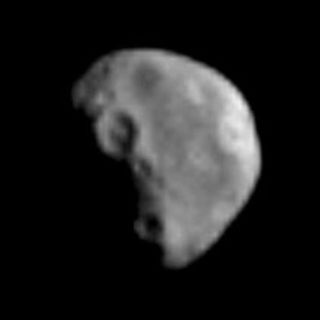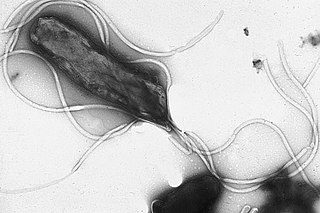Related Research Articles
Comet Shoemaker–Levy 9 broke apart in July 1992 and collided with Jupiter in July 1994, providing the first direct observation of an extraterrestrial collision of Solar System objects. This generated a large amount of coverage in the popular media, and the comet was closely observed by astronomers worldwide. The collision provided new information about Jupiter and highlighted its possible role in reducing space debris in the inner Solar System.

Galileo was an American robotic space program that studied the planet Jupiter and its moons, as well as several other Solar System bodies. Named after the Italian astronomer Galileo Galilei, the Galileo spacecraft consisted of an orbiter and an atmospheric entry probe. It was delivered into Earth orbit on October 18, 1989, by Space ShuttleAtlantis on the STS-34 mission, and arrived at Jupiter on December 7, 1995, after gravity assist flybys of Venus and Earth, and became the first spacecraft to orbit Jupiter. The spacecraft then launched the first probe to directly measure its atmosphere. Despite suffering major antenna problems, Galileo achieved the first asteroid flyby, of 951 Gaspra, and discovered the first asteroid moon, Dactyl, around 243 Ida. In 1994, Galileo observed Comet Shoemaker–Levy 9's collision with Jupiter.

Ida, minor planet designation 243 Ida, is an asteroid in the Koronis family of the asteroid belt. It was discovered on 29 September 1884 by Austrian astronomer Johann Palisa at Vienna Observatory and named after a nymph from Greek mythology. Later telescopic observations categorized Ida as an S-type asteroid, the most numerous type in the inner asteroid belt. On 28 August 1993, Ida was visited by the uncrewed Galileo spacecraft while en route to Jupiter. It was the second asteroid visited by a spacecraft and the first found to have a natural satellite.
Peptic ulcer disease is a break in the inner lining of the stomach, the first part of the small intestine, or sometimes the lower esophagus. An ulcer in the stomach is called a gastric ulcer, while one in the first part of the intestines is a duodenal ulcer. The most common symptoms of a duodenal ulcer are waking at night with upper abdominal pain, and upper abdominal pain that improves with eating. With a gastric ulcer, the pain may worsen with eating. The pain is often described as a burning or dull ache. Other symptoms include belching, vomiting, weight loss, or poor appetite. About a third of older people with peptic ulcers have no symptoms. Complications may include bleeding, perforation, and blockage of the stomach. Bleeding occurs in as many as 15% of cases.

(243) Ida I Dactyl is a tiny asteroid moon that orbits asteroid 243 Ida. It was imaged by the Galileo spacecraft on August 28, 1993; Dactyl was discovered while examining the delayed image downloads from Galileo on February 17, 1994. It was provisionally designated S/1993 (243) 1. The satellite was named after the mythical creatures called dactyls, who, according to Greek mythology, lived on Mount Ida.

Barry James Marshall is an Australian physician, Nobel Laureate in Physiology or Medicine, Professor of Clinical Microbiology and Co-Director of the Marshall Centre at the University of Western Australia. Marshall and Robin Warren showed that the bacterium Helicobacter pylori plays a major role in causing many peptic ulcers, challenging decades of medical doctrine holding that ulcers were caused primarily by stress, spicy foods, and too much acid. This discovery has allowed for a breakthrough in understanding a causative link between Helicobacter pylori infection and stomach cancer.

Upper gastrointestinal bleeding is gastrointestinal bleeding (hemorrhage) in the upper gastrointestinal tract, commonly defined as bleeding arising from the esophagus, stomach, or duodenum. Blood may be observed in vomit or in altered form as black stool. Depending on the amount of the blood loss, symptoms may include shock.
The year 1995 in science and technology involved many significant events, listed below.
The year 1994 in science and technology involved many significant events, listed below.
The year 1991 in science and technology involved many significant events, some listed below.
The year 1997 in science and technology involved many significant events, listed below.
(45) Eugenia I Petit-Prince is the larger, outer moon of asteroid 45 Eugenia. It was discovered in 1998 by astronomers at the Canada-France-Hawaii Telescope on Mauna Kea, Hawaii. Initially, it received the provisional designation S/1998 (45) 1. Petit-Prince was the first asteroid moon to be discovered with a ground-based telescope. Previously, the only known moon of an asteroid was Dactyl, discovered by the Galileo space probe, around 243 Ida.
The year 1990 in science and technology involved some significant events.
The year 1986 in science and technology involved many significant events, some not listed below.
The year 1950 in science and technology included some significant events.
The year 1949 in science and technology involved some significant events, listed below.

John Robin Warren is an Australian pathologist, Nobel Laureate and researcher who is credited with the 1979 re-discovery of the bacterium Helicobacter pylori, together with Barry Marshall. The duo proved to the medical community that the bacterium Helicobacter pylori is the cause of most peptic ulcers.

Sucralfate, sold under various brand names, is a medication used to treat stomach ulcers, gastroesophageal reflux disease (GERD), radiation proctitis, and stomach inflammation and to prevent stress ulcers. Its usefulness in people infected by H. pylori is limited. It is used by mouth and rectally.

This is a timeline of the events relating to the discovery that peptic ulcer disease and some cancers are caused by H. pylori. In 2005, Barry Marshall and Robin Warren were awarded the Nobel Prize in Physiology or Medicine for their discovery that peptic ulcer disease (PUD) was primarily caused by Helicobacter pylori, a bacterium with affinity for acidic environments, such as the stomach. As a result, PUD that is associated with H. pylori is currently treated with antibiotics used to eradicate the infection. For decades prior to their discovery, it was widely believed that PUD was caused by excess acid in the stomach. During this time, acid control was the primary method of treatment for PUD, to only partial success. Among other effects, it is now known that acid suppression alters the stomach milieu to make it less amenable to H. pylori infection.

Jack William Szostak is a Canadian American biologist of Polish British descent, Nobel Prize laureate, University Professor at the University of Chicago, former Professor of Genetics at Harvard Medical School, and Alexander Rich Distinguished Investigator at Massachusetts General Hospital, Boston. Szostak has made significant contributions to the field of genetics. His achievement helped scientists to map the location of genes in mammals and to develop techniques for manipulating genes. His research findings in this area are also instrumental to the Human Genome Project. He was awarded the 2009 Nobel Prize for Physiology or Medicine, along with Elizabeth Blackburn and Carol W. Greider, for the discovery of how chromosomes are protected by telomeres.
References
- ↑ Chapman, Clark R. (October 1996). "S-Type Asteroids, Ordinary Chondrites, and Space Weathering: The Evidence from Galileo's Fly-bys of Gaspra and Ida". Meteoritics. 31 (6): 699–725. Bibcode:1996M&PS...31..699C. doi:10.1111/j.1945-5100.1996.tb02107.x.
- ↑ Gordon, N. J.; Salmond, D. J.; Smith, A. F. M. (1993). "Novel approach to nonlinear/non-Gaussian Bayesian state estimation". IEE Proceedings F - Radar and Signal Processing. 140 (2). Institution of Electrical Engineers: 107. doi:10.1049/ip-f-2.1993.0015. ISSN 0956-375X.
- ↑ Bonaparte J. F.; Coria R. A. (1993). "Un nuevo y gigantesco sauropodo titanosaurio de la Formacion Rio Limay (Albiano-Cenomaniano) de la Provincia de Neuquen, Argentina". Ameghiniana. 30 (3): 271–82.
{{cite journal}}: CS1 maint: multiple names: authors list (link) - ↑ Hamer, D.; Hu, S.; Magnuson, V.; Hu, N.; Pattatucci, A. (1993). "A linkage between DNA markers on the X chromosome and male sexual orientation". Science . 261 (5119): 321–7. Bibcode:1993Sci...261..321H. doi:10.1126/science.8332896. PMID 8332896.
- ↑ Mojica, F. J.; Juez, G.; Rodríguez-Valera, F (1993). "Transcription at different salinities of Haloferax mediterranei sequences adjacent to partially modified PstI sites". Molecular Microbiology . 9 (3): 613–621. doi:10.1111/j.1365-2958.1993.tb01721.x. PMID 8412707. S2CID 23548049 . Retrieved 2021-03-19.
- ↑ "History of Prosthetics". Blatchford & Sons, Ltd. Archived from the original on 2008-04-10. Retrieved 2008-03-16.